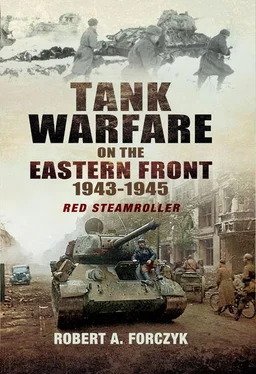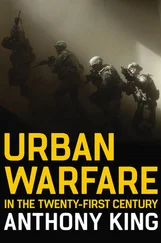Between July and December 1942, the German armoured units on the Eastern Front had lost 1,256 tanks as Totalausfalle , [2]while receiving 1,365 replacement tanks – so German tank strength had actually increased slightly during the 1942 campaign. Indeed, when the Soviets began their winter counter-offensives in November 1942, the Germans had 40 per cent more operational tanks than they had possessed at the start of Case Blau in July. However, the Panzer units on the Eastern Front only received 67 per cent of the tanks built in the period July– December 1942 and this percentage actually dropped to just 60 per cent in the final three months of the year due to the crisis in North Africa. {4} The remaining 33–40 percent of German tank production was not going to the Eastern Front, but to other fronts or retained for training new units. Thus, the Panzer-Divisionen on the Eastern Front received just enough replacements to maintain their authorized strength, with no real theatre reserves of replacements. A normal rule of thumb is that a mechanized army should try to maintain a 10 per cent over-strength of key weapons, like tanks, in a category called ‘Operational Readiness Floats’, which are in-theatre spares to replace losses. Without a reserve of spares, natural attrition meant that German Panzer-Divisionen at the front could not be kept at authorized strength levels. Nevertheless, if German theatre logistics had been adequate, this approach might have sufficed.
The OKH Panzer Reserve was located at Sagan in Silesia. After acceptance from the manufacturers in Germany, new panzers typically arrived by rail at Sagan, where they were either forwarded on to front-line units in Russia or kept temporarily in holding depots at Vienna. The OKH decided the priority of where new tanks would be sent, but the logic employed was arcane; for example, sending Tigers to the Leningrad Front where terrain was clearly unfavourable for the use of heavy tanks. Normally, replacement tanks were sent in small groups, usually 10–20, to specific Panzer-Divisionen. This method of injection kept combat units going and spread the resources around, but prevented them from ever getting back up to full strength.
Furthermore, the weakness of German theatre-level supply greatly undermined German armoured strength on the Eastern Front, which was built on a logistical house of cards. The advances of 1941–42 had brought the German Panzer-Divisionen very far from their logistical support bases in Eastern Europe and the homeland, which greatly complicated field and depot-level repairs on vehicles. In the Caucasus for example, Heeresgruppe A was dependent upon a single-track rail line to supply Panzerarmee 1 (PzAOK 1), which was grossly inadequate for receiving regular supplies of fuel and spare parts. At Rzhev, the main rail line from Vyazma was never converted to standard gauge, so the 9.Armee was forced to fight off Zhukov’s Operation Mars offensive while receiving no more than two supply trains per day.
The lack of standardization in spare parts was a particular disadvantage for German armour, compared to the standardization witnessed in the Soviet and Anglo-American tank fleets. When units lacked adequate spare parts to restore damaged vehicles they were wont to resort to cannibalization (also known as ‘controlled substitution’: taking parts from one or more damaged tanks to repair at least one tank) to keep tanks running, but cannibalization resulted in tanks being stripped for parts. Normally, tanks in heavy use should receive some kind of depot-level service every three to six months to restore their systems, particularly the suspension and engine-train. Field-level maintenance can keep tanks running for weeks or months, but minor problems will gradually escalate into major problems that cannot be readily fixed in the field – like a ruptured fuel cell. Certain types of combat damage could also be repaired in the field and some tanks were ‘knocked out’ multiple times, but usually depot-level maintenance was required to restore a tank to full fighting trim. Sending a damaged tank back to Germany for depot-level maintenance meant that it might be gone for many weeks and in the meantime, the unit was down another tank. Consequently, German under-strength Panzer units tended to keep large numbers of non-operational tanks up-front with them, hoping that through cannibalization and various field expedients they could keep a reasonable number of tanks operational. For example, if a tank had the electrical motor for its turret traverse burned out and there were no spare motors available, the tank could still use manual traverse – even though this put the crew at much greater risk in a tank engagement. The result was that tanks kept at the front, operating in ‘degraded mode’, were rather fragile. When winter arrived, the ‘degraded’ tanks tended to be the first to fall out.
The German logistic infrastructure supporting their panzers tended to fail whenever units were forced to retreat any great distance, when snow/ice/mud turned the Russian roads into glue, or when Soviet partisans succeeded in interfering with the lines of communication. This weakness was particularly apparent when the Soviets broke through Heeresgruppe B’s front along the Don in late 1942. German supply bases were overrun and often had to be abandoned due to lack of transport. This lack of operational mobility – insufficient trains, long-haul trucks and air transport planes – proved to be the Achilles’ heel that nearly brought German armoured strength to its knees in the winter of 1942–43. Essentially, German theatre logistics on the Eastern Front had no leeway and even minor disruptions could halt or delay the timely delivery of critical spare parts, ammunition and fuel to forward areas.
On 28 February 1943, Hitler appointed Generaloberst Heinz Guderian as Inspekteur der Panzertruppen . Guderian had been unemployed in the Führer-Reserve since Hitler had relieved him of command in December 1941, but now Hitler needed Guderian’s organizational talents to restore the depleted Panzer units on the Eastern Front. Guderian demanded a broad authority over all armoured units, included those belonging to the Waffen-SS and the Luftwaffe. However, Guderian lost the bureaucratic battle with the Sturmartillerie branch, which blocked his efforts to gain control over their assault guns, and the Panzerjäger branch also managed to retain considerable autonomy. Guderian wasted no time in drawing up a lengthy memorandum for Hitler on how to rejuvenate the Panzer-Divisionen, which was presented to the Führer on 9 March 1943.
In its main points, Guderian’s memorandum stated:
The task for 1943 is to provide a certain number of Panzer-Divisionen with complete combat efficiency capable of making limited objective attacks. A Panzer-Division only possesses complete combat efficiency when the number of its tanks is in correction proportion to its other weapons and vehicles. German Panzer-Divisionen were designed to contain 4 Panzer-Abteilungen with a total of roughly 400 tanks per division… at the moment, we unfortunately have no Panzer-Divisionen which can be said to possess complete combat efficiency. Our success in battle this year, and even more so next year, depends on the recreation of that efficiency. So the problem is this: without delay, and regardless of all special interests, to recreate Panzer-Divisionen with complete combat efficiency. {5}
Hitler agreed with many of Guderian’s points and respected his technical expertise, but failed to back him in the various inter-service and intra-service bureaucratic battles. While Guderian was able to achieve some limited successes in organizational reform and training, his belief in the necessity of rebuilding the Heer Panzer-Divisionen on the Eastern Front met with negligible success. Above all, Guderian’s sound argument for the creation of a sizeable strategic armoured reserve under the control of the Oberkommando des Heeres (OKH) was a complete failure. Yet it should also be noted that in many respects, Guderian was overly attached to a dated, tank-heavy conception of what a Panzer-Division should look like, in that a 100-tank battalion was far too unwieldy and providing a 1943 Panzer-Division with 400 medium tanks was both impractical and unnecessary. In contrast, even a full-strength Soviet tank corps in late 1943 was only equipped with 200 T-34 medium tanks in three tank brigades.
Читать дальше








![John Stieber - Against the Odds - Survival on the Russian Front 1944-1945 [2nd Edition]](/books/405234/john-stieber-against-the-odds-survival-on-the-russian-front-1944-1945-2nd-edition-thumb.webp)



